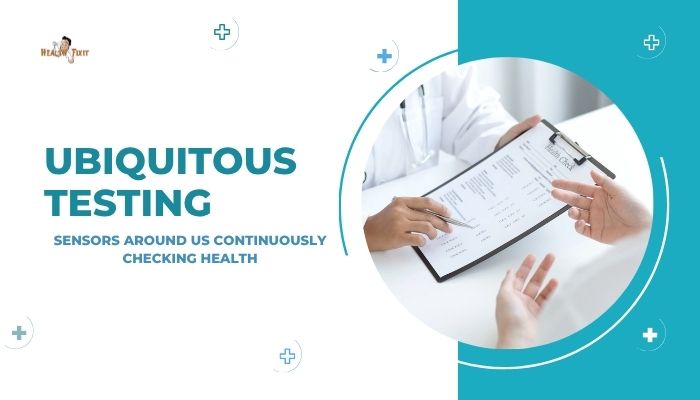Introduction
Imagine a world where your home, car, or office constantly tracks subtle changes in your health—without intrusive hospital visits
. This is the vision of ubiquitous health testing, leveraging sensor-laden devices to provide continuous data on vitals, biochemical markers,
or environmental factors that influence well-being. These sensors might be embedded in furniture, clothing,
or everyday objects—quietly and seamlessly collecting information about your body and environment.
As technology and data analytics advance, this approach could revolutionize preventive care, spotting early warning signs of chronic illness or infection.
This article explores the promise, practicality, and ethical challenges of an “always-on” health monitoring ecosystem.
Why Ubiquitous Testing?
From Periodic Checkups to Continuous Tracking
Traditional healthcare often relies on episodic doctor visits or labs—like an annual physical or irregular screenings. Meanwhile
, subtle daily fluctuations may go unnoticed until issues become acute. Ubiquitous sensors can fill these gaps, providing real-time or near-real-time insight and faster interventions.
Personalized, Preventive Care
With consistent data streams, AI models can learn each individual’s “baseline,” quickly flagging anomalies (e.g., rising heart rate variability,
mild fever). This approach fosters precision health—actionable tips to adjust diet, activity, or medication well before serious symptoms occur.
Empowering Patients
Constant feedback loops might reduce anxiety by offering clarity on health trends, or motivate behavior change through immediate evidence of progress (or regression). Conversely, it can also reduce unnecessary clinic visits if routine at-home sensors show stable metrics.
The Technology Behind Ubiquitous Health Monitoring
Wearable and Ambient Sensors
- Wearables: Smartwatches, patches, or rings tracking heart rate, SpO₂, EKG, sweat composition.
- Ambient Sensors: Surfaces or devices (smart mirrors, seats, or toilet systems) measure posture, weight, or urine/blood biomarkers.
- Imaging: Some advanced setups might embed mini camera-based sensors for gait analysis or subtle facial temperature changes (thermography).
Wireless Connectivity
Secure connections via Bluetooth, Wi-Fi, or 5G stream data to centralized health platforms or personal devices
. Edge computing may process signals locally—ensuring immediate alerts if critical changes appear. For large-scale adoption, robust networking is essential to handle continuous data flows.
AI-Driven Analytics
Machine learning models interpret raw data from many sensor types—identifying patterns correlated with specific conditions. By merging user context (age, medical history) with daily sensor feeds, AI can deliver personalized insights or prompt medical interventions.
Potential Health Benefits
Early Disease Detection
A slight rise in resting heart rate or body temperature over consecutive days might herald an infection or autoimmune flare
. Continuous monitoring could alert users early, enabling timely medical attention. Similarly, small changes in oxygen saturation might help catch respiratory ailments sooner.
Chronic Condition Management
For conditions like heart failure or diabetes, at-home monitoring of fluid retention or glucose trends can curb hospital readmissions. Real-time feedback (like smartphone alerts) might encourage medication adherence or diet adjustments, reducing complications.
Pandemic Preparedness
During global health crises, networks of home-based sensors could track population-level fevers or respiratory changes—functioning as an early warning system for community outbreaks.
Public health authorities might respond faster, imposing targeted measures rather than broad lockdowns.
Challenges and Considerations
Accuracy and Validation
Not all consumer devices offer clinical-grade reliability. Ensuring medical-grade sensors that produce consistent, validated measurements is critical to avoid false alarms or missed diagnoses.
Data Overload and Integration
Vast data streams from numerous sensors can swamp users and providers. Effective data filtering, AI analytics, and user-friendly dashboards are needed so that only pertinent alerts or patterns surface.
Privacy and Security
Continuous, passive data collection poses privacy risks. Malicious actors might glean sensitive health details. Ironclad encryption, transparent data policies, and robust consent frameworks are essential to maintain trust.
Behavioral and Ethical Dimensions
Constant monitoring might encourage beneficial lifestyle changes, but it can also fuel anxiety or surveil individuals.
Striking a balance—empowering patients without creating a sense of being perpetually watched—is key. In addition, ensuring equitable access for all communities is vital to avoid health disparities.
The Road Ahead
Partnerships and Standardization
Integrating sensors from multiple manufacturers requires interoperable data formats and universal standards. Partnerships between device makers, software firms, and healthcare systems can yield cohesive solutions, not fragmented silos.
AI Coaching and Telehealth
Over time, advanced AI might become a “virtual nurse,” scanning your daily sensor feed to offer tips, schedule telehealth sessions, or highlight potential medication changes. For many, especially in rural zones, that means quicker, more accessible care guidance.
Evolving Payment Models
Reimbursement for remote patient monitoring or data interpretation will shape adoption. As payers see cost savings from preventing hospital admissions, coverage for ubiquitous testing might expand. This fosters a supportive financial environment for these innovations.
Practical Tips for Adopting Ubiquitous Testing
- Start Small: Try one or two vetted wearable sensors, focusing on a key metric (blood pressure, heart rate), ensuring reliability and personal relevance.
- Ensure Data Security: Choose devices with strong encryption and HIPAA-compliant practices if data ties to your medical records.
- Integrate with Providers: Confirm your physician or care team can interpret your device’s output. Many EHR systems now integrate with wearable data, but not all.
- Track Over Time: Single readings matter less than trends. Monitor patterns, check consistent usage, and address anomalies with medical advice.
Conclusion
Ubiquitous health testing stands poised to transform how we detect and manage disease—from daily at-home sensor checks to entire networks that feed real-time data into AI-driven systems.
By merging wearable or ambient sensors with advanced analytics, individuals can shift from reactive care to proactive
, near-constant health vigilance. Though technical, privacy, and regulatory hurdles remain, the potential payoff includes earlier diagnoses
, better chronic disease control, and a more inclusive healthcare landscape. As the technology matures,
ubiquitous testing could usher in an era of continuous, unobtrusive health monitoring—providing personalized and preventive care that keeps people healthier, longer.
References
- Steinhubl SR, Topol EJ. Digital medicine, personalized health, and new technologies: synergy and pitfalls. Nat Rev Cardiol. 2019;16(2):91–96.
- Majmudar MD, Harrington RA, Brown N, Graham G. Wearable sensors for remote health monitoring. J Am Coll Cardiol. 2015;66(4):321–329.
- Yoo JY, et al. Ubiquitous health monitoring. IEEE Rev Biomed Eng. 2020;13:500–517.
- Weenk M, et al. Continuous health monitoring in hospitals using wearable sensors: a systematic review. Sensors. 2020;20(23):6873.
- Boulos MNK, et al. Connected wearable sensors and AI in global health. Sensors. 2018;18(10):3288.
- Czaja SJ. Designing for older adults: bridging technology and health. CRC Press; 2019.
- Lorgelly PK, et al. Realizing the value of digital health: multiple stakeholder perspectives. Digit Health. 2020;6:2055207620968534.
- Khan WZ, et al. Big data analytics and IoT for ubiquitous health monitoring. Comput Ind Eng. 2021;151:106960.
- Perera C, et al. Privacy and security concerns in continuous patient monitoring. IEEE Internet Things J. 2020;7(10):9784–9794.
- Wolf JA, et al. Prognostic wearable sensors: bridging the patient–doctor gap in chronic care. NPJ Digit Med. 2020;3(1):1–7.





